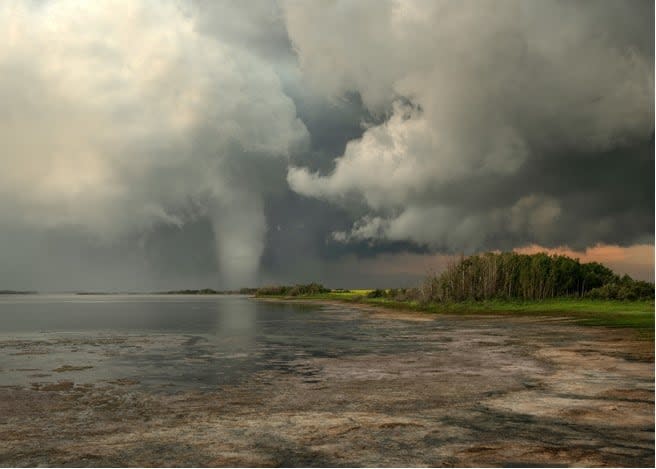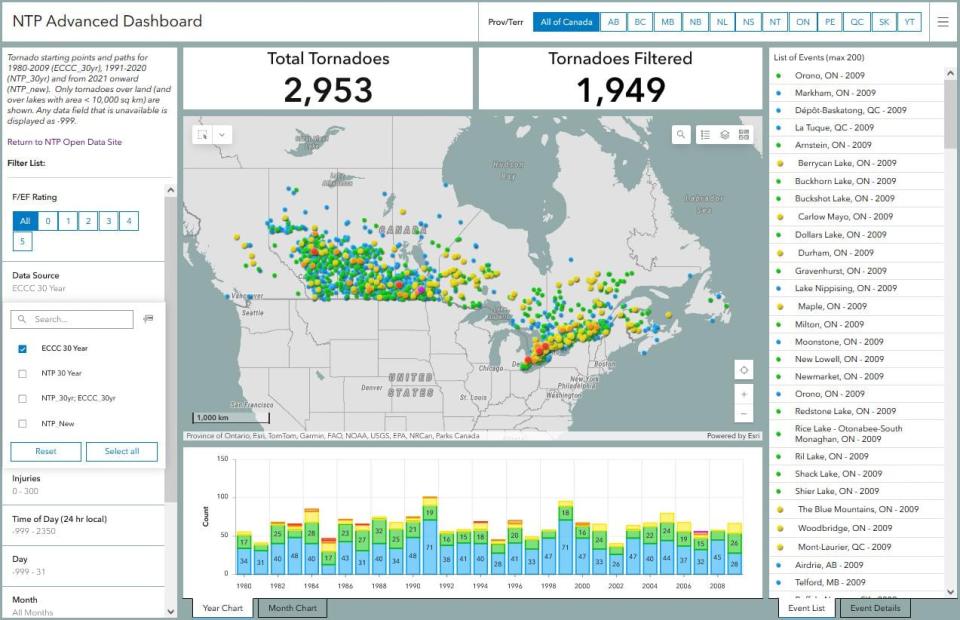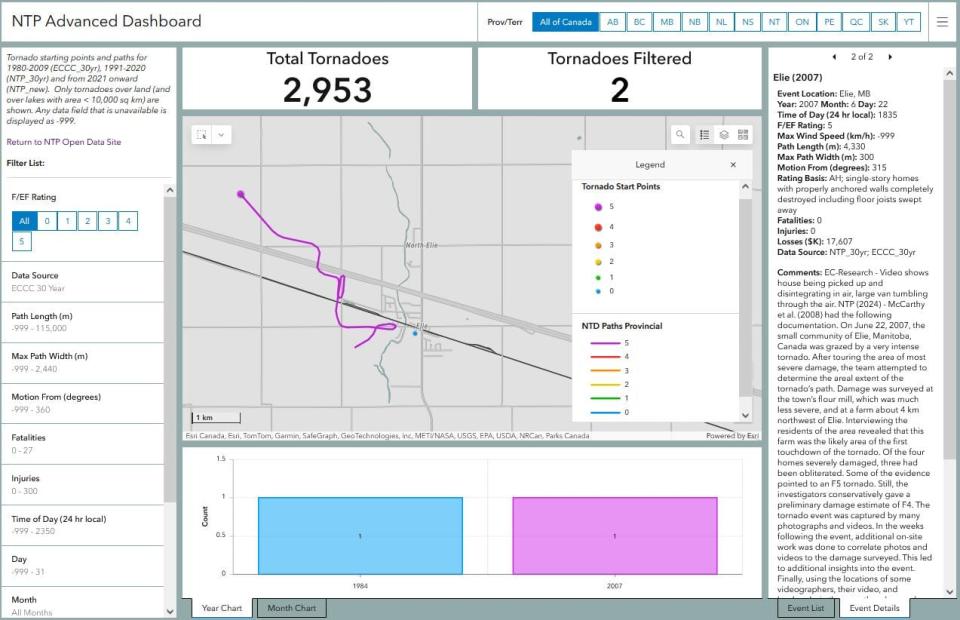A new online portal sheds light on hundreds of known, formerly unknown Canadian tornadoes

Amateur tornado enthusiasts and professional climate researchers alike now have an easier way to pour over decades of Canadian tornado data, thanks to the London, Ont.-based Northern Tornadoes Project (NTP).
The group, headquartered out of Western University, unveiled a new, advanced online dashboard on Friday that allows users to view and dissect detailed tornado data going back to 1980, including data for several hundred twisters that were previously unreported.
The available data spans 1980 to 2023, and the group plans to add even older data to the dashboard, stretching back to Canada's first documented tornado in 1792, said David Sills, NTP's executive director.
"The research community uses this kind of data for scientific studies. There is industry that is looking to determine risk levels. Municipalities and provinces use the data for management risk," Sills said of the new portal, which features tornado path visualizations that weren't available before.
"The number of uses for this data goes far beyond what we can imagine."

The NTP's new advanced dashboard includes data from more than 250 tornadoes over the past four decades that were previously undocumented. (Northern Tornadoes Project)
Data presented in the new dashboard is the result of several years of work by NTP team members, who scrutinized old satellite imagery, climate data, newspaper reports, and other resources to examine past tornadoes and identify any new ones.
The process was outlined in a study published early last year in the American Meterological Society's Journal of Applied Meteorology and Climatology.
Researchers confirmed over 250 previously undocumented tornadoes across the country for the 43 years starting in 1980, a vast majority of them in Ontario and Quebec, Sills said. The highest number of unreported tornadoes occurred in 2015, with at least 23, the study says.
At least 110 of the twisters were missing from a 30-year dataset covering 1980 to 2009 that Sills helped compile roughly a decade ago. Researchers also identified 45 new tornado-related fatalities in that three-decade period.
"We found major tornadoes with very long tracks through the forest and sometimes fairly close to urban areas. They just couldn't tell that there was a long track there without satellite imagery," he said.
"Hundreds of tornadoes have been found across most of the boreal forests of Canada, right from one end of the country to the other, and we have a much better idea, in those areas, of tornado risk now."
The work also led to the review of established tornado events, including a 2006 one that hit Argyle, N.B. After reviewing new evidence, the team upgraded the twister from F-1 strength to F-2, and located the path of a second F-2 tornado — which hadn't been documented — to the east.
(Environment Canada began using the enhanced Fujita scale, EF, replacing the original Fujita scale, F, in April 2013, with the higher the number, the more intense the storm. Most tornadoes are classified as weak (EF-0 and EF-1).

The new advanced dashboard includes enhanced path detail for a number of tornadoes, including the EF-5 twister that hit Elie, Man., in 2007. Path data for more tornadoes will be added in the future. (Northern Tornadoes Project)
One major surprise, Sills said, was the number of undocumented tornadoes they identified in Quebec, specifically in forests north of the Montreal-Quebec City corridor.
"It's really a hotbed of tornadoes," he said.
"It may be part of a shift towards tornadoes occurring more in the eastern part of the continent than in the western part. Certainly, that's a trend that's been picked up in the U.S.," he said, adding it's unclear whether it may be linked to climate change.
For Adam Skinner, creator of the severe weather alert platform Instant Weather, the historical data will help improve weather tornado probability modelling and debunk the myth that tornadoes only occur south of the border.
"So many folks are, 'Oh, tornadoes don't happen here. They only happen down in the U.S. It's so rare.' I think if people see the data of tornadoes occurring where they live or close by, maybe they'll be a little bit more weather aware," he said.
Skinner said some of the data used by NTP comes from community tips sent to Instant Weather through its popular Facebook page, Ontario Storm Watch, and the Facebook group Ontario Storm Reports.
"The NTP has been fantastic with, not only putting together the data, and filtering through it and making sure it's as complete as possible, but also they're actually helping Environment Canada go and verify tornadoes," he said.
"Ultimately, the more data we have, the better the models get, the better the forecasting gets. It's a win-win for everybody."
NTP officials said the advanced dashboard will be updated once or twice a year. The group's existing dashboard, which features data from NTP's foundation in 2017 onward, will be updated regularly as tornadoes occur.

